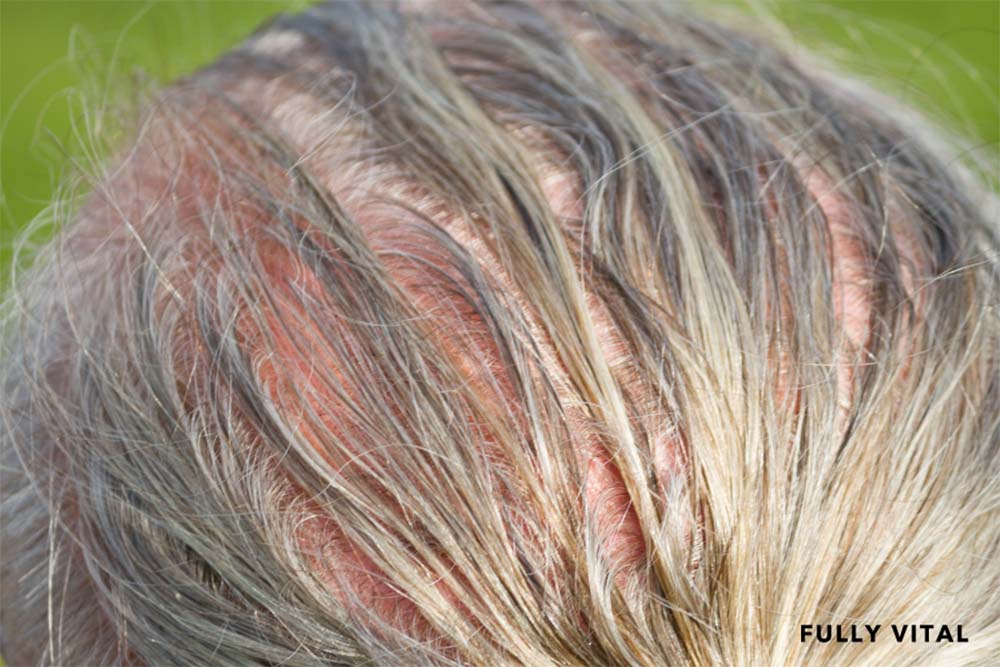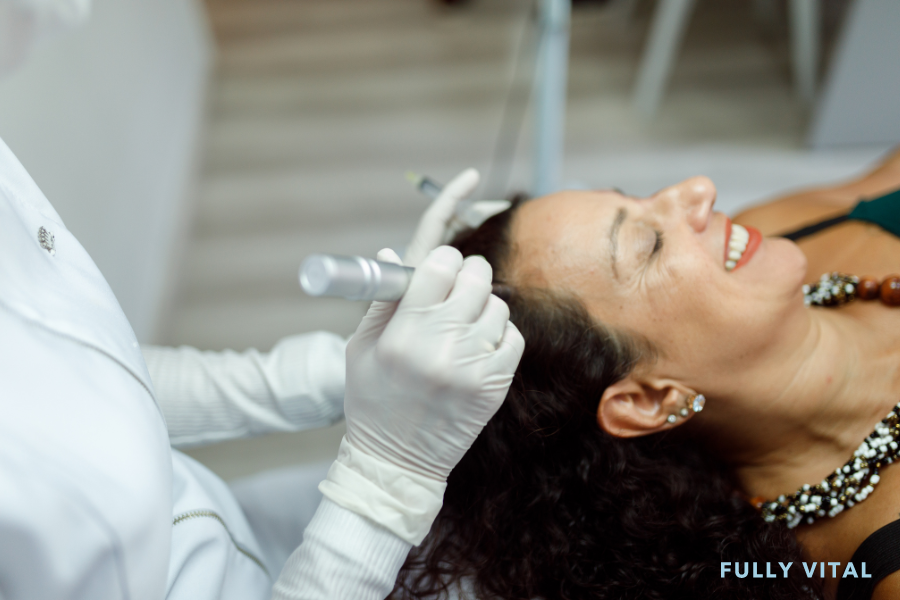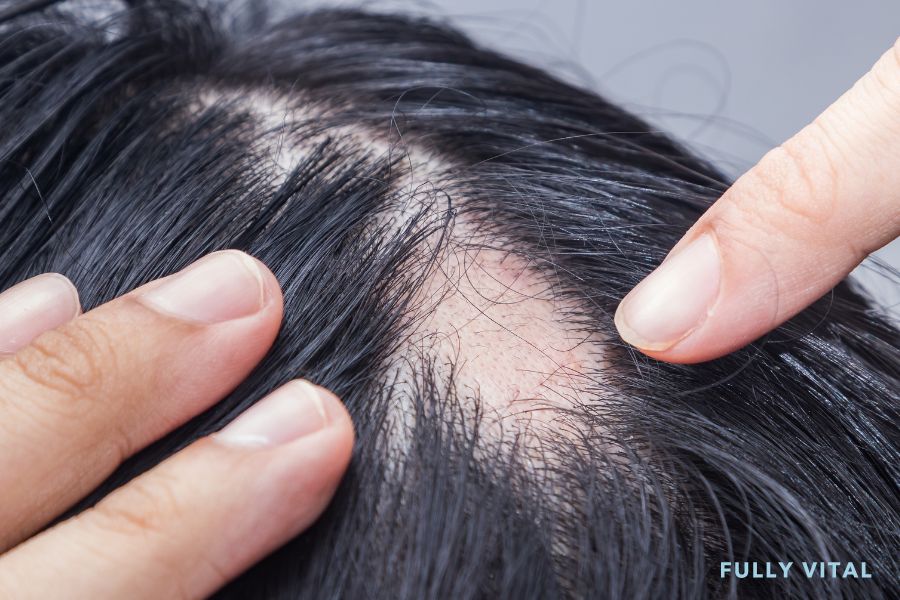
Alopecia Mucinosa: Understanding And Managing Hair Loss
If you're a woman searching for ways to stimulate hair growth and regain your luscious locks, you've come to the right place.
Welcome to our comprehensive guide on alopecia mucinosa – a condition that affects hair growth.
In this article, we'll delve into the details of alopecia mucinosa, why it's crucial to comprehend, its causes, benefits of management, potential downsides, and alternative treatment options.
Let's get started!

I LOVE MY HAIR NOW
FullyVital hair serum and hair vitamins made tremendous improvements in my hair. I truly love my hair now.
Dorit S.,
What Is Alopecia Mucinosa?
Alopecia mucinosa is a relatively rare but notable condition that can impact hair growth.
It falls under the category of primary lymphocytic scarring alopecia and is characterized by the presence of mucin (a gel-like substance) around hair follicles.
This condition can lead to hair loss and thinning, prompting the need for effective management strategies.

Why Is Understanding Alopecia Mucinosa Important?
Understanding alopecia mucinosa is essential for anyone seeking to address hair loss concerns.
By grasping the nuances of this condition, you empower yourself to make informed decisions about its management.
Knowledge about alopecia mucinosa enables you to explore suitable treatments and regain your hair confidence.
How Does Alopecia Mucinosa Occur?
Alopecia mucinosa occurs when mucin accumulates around hair follicles, leading to inflammation and scarring.
This process can disrupt the natural hair growth cycle, resulting in hair loss.
The exact cause of alopecia mucinosa is not fully understood, but factors like genetics and immune system responses are believed to play a role.1
What Are The Benefits Of Managing Alopecia Mucinosa?
Effectively managing alopecia mucinosa comes with several benefits:
-
Hair Regrowth: Implementing proper management strategies can encourage hair regrowth in affected areas.
-
Boosted Confidence: Restoring hair growth can boost self-confidence and enhance overall well-being.
-
Early Intervention: Timely management can prevent further hair loss and minimize scarring.
-
Understanding Your Body: Managing alopecia mucinosa promotes a deeper understanding of your body's reactions and needs.
Are There Any Downsides To Managing Alopecia Mucinosa?
While managing alopecia mucinosa offers numerous advantages, it's important to consider potential downsides as well:
-
Patience Required: Results may take time to become visible, requiring patience and commitment.
-
Variability: Responses to treatments can vary among individuals, making the outcome unpredictable.
-
Cost of Treatments: Some effective treatments might involve costs, impacting financial considerations.
What Are The Alternatives In Treating Alopecia Mucinosa?
When it comes to treating alopecia mucinosa, various alternatives are available:
Topical Corticosteroids
These anti-inflammatory medications can help manage inflammation around hair follicles.
Intralesional Corticosteroid Injections
Direct injections into affected areas can reduce inflammation and encourage hair growth.
Immunomodulatory Treatments
Medications that modulate the immune response can be effective in managing alopecia mucinosa.
Light Therapy (Phototherapy)
Controlled exposure to specific wavelengths of light can promote hair regrowth.
Hair Transplantation
In cases of extensive hair loss, hair transplantation might be considered for restoring hair density.
What Causes Alopecia Mucinosa?
Alopecia mucinosa's exact cause is not fully understood, but several factors are believed to contribute to its development.
These factors include:
-
Immune System Aberrations: An abnormal immune response targeting hair follicles and causing inflammation.
-
Genetic Predisposition: Certain genetic factors may increase the likelihood of developing alopecia mucinosa.
-
Autoimmune Components: The condition is thought to have autoimmune components, where the immune system attacks healthy hair follicles.
-
Environmental Triggers: Environmental factors or triggers might play a role in initiating or exacerbating the condition.
Our Best Sellers
What Are The Different Types Of Alopecia Mucinosa?
Alopecia mucinosa manifests in various forms, including:
Plaque Type
Characterized by thick, raised, and reddish-brown plaques with areas of hair loss.
Tumor Type
Presents as solitary or grouped tumors on the scalp or other body parts, with hair loss within the affected area.
Follicular Mucinosis
Involves hair follicle inflammation and mucin accumulation, leading to hair loss.
How Is Alopecia Mucinosa Diagnosed?
Diagnosing alopecia mucinosa typically involves a combination of medical history, clinical examination, and diagnostic tests, such as:
-
Skin Biopsy: A small skin sample is taken and examined under a microscope to confirm the presence of mucin and assess inflammation.
-
Blood Tests: These tests help rule out other underlying conditions that might mimic the symptoms of alopecia mucinosa.
What Are The Symptoms of Alopecia Mucinosa?
The symptoms of alopecia mucinosa include the development of thick, scaly patches known as plaques on the skin.
These plaques often result in localized hair loss and may be accompanied by itching or discomfort.2
In some cases, raised reddish-brown tumors can form on the affected area, further contributing to hair loss.
This condition can also involve hair follicles being surrounded by a gel-like substance, leading to inflammation and potential hair loss.
What Is The History Of Alopecia Mucinosa?
The history of alopecia mucinosa sheds light on the evolution of our understanding of this condition:
-
Early Observations: The first documented cases of alopecia mucinosa date back to the early 20th century, highlighting the long-standing existence of this condition.
-
Diagnostic Advances: Over the years, advances in dermatology and diagnostic techniques have refined our ability to accurately diagnose and differentiate alopecia mucinosa from other hair loss conditions.
-
Treatment Progress: Historical records of treatment approaches showcase the progression from limited options to the diverse range of treatments available today.
Our Best Sellers
What Is The Current Environment Surrounding Alopecia Mucinosa?
Examining the present landscape of alopecia mucinosa allows us to tailor our approach to effectively address the needs of our audience:
-
Awareness and Education: Increased awareness about alopecia mucinosa, fueled by the digital age, empowers individuals to seek timely diagnosis and appropriate treatments.3
-
Research and Innovation: Ongoing research contributes to a deeper understanding of the condition's underlying mechanisms, leading to more targeted and effective treatment options.
-
Patient Support: Online communities and support groups provide platforms for individuals to share experiences, offer advice, and find solace in a supportive network.
What Is The Future Of Alopecia Mucinosa?
Anticipating the future trends of alopecia mucinosa guides our commitment to providing relevant and effective solutions:
-
Personalized Treatments: Advances in genetics and personalized medicine might lead to treatment plans tailored to each individual's genetic makeup and specific characteristics.
-
Technological Integration: Emerging technologies could enhance diagnosis accuracy and treatment efficacy, making use of tools such as AI-driven diagnostics and targeted therapies.
-
Holistic Approach: A holistic approach encompassing both medical and psychological aspects of the condition could pave the way for comprehensive management strategies.
Unlock Radiant Hair With Fully Vital's Hair Growth Products!At Fully Vital, we're passionate about nurturing your hair's natural beauty. Our science-backed hair growth products are meticulously crafted to halt and even reverse the aging process of your hair. Discover the power of:
At Fully Vital, we're more than just a brand – we're your partner in embracing hair growth and confidence. Join us on the journey to revitalized, timeless hair. |
Final Thoughts On Alopecia Mucinosa
In the quest for vibrant and voluminous hair, understanding conditions like alopecia mucinosa plays a pivotal role.
By unraveling the intricacies of this condition, we empower ourselves to make informed decisions about our hair health journey.
From delving into the causes and symptoms of alopecia mucinosa to exploring its management strategies and future prospects, we've embarked on a comprehensive exploration.
This knowledge equips us to take charge of our hair growth goals and address any challenges that come our way.
At Fully Vital, we're committed to supporting you in your pursuit of healthy and radiant hair.
Our range of hair growth products is designed to halt the aging process of your hair, allowing you to cultivate a nourishing relationship with your locks.
As you navigate the diverse landscape of hair care, remember that knowledge is key, and you're not alone on this journey.
Let's embrace the potential for hair growth, seize the opportunity for confidence, and stride forward with the wisdom gained from understanding alopecia mucinosa.
Your hair deserves the best, and we're here to help you achieve it.
Frequently Asked Questions About Alopecia Mucinosa
Is alopecia mucinosa a common condition?
Alopecia mucinosa is relatively rare compared to other forms of hair loss.
Can alopecia mucinosa be cured completely?
While there's no guaranteed cure, effective management can lead to significant hair regrowth.
Are there any home remedies I can try?
Home remedies might not provide substantial results for managing alopecia mucinosa.
Consulting a dermatologist is recommended.
Is alopecia mucinosa hereditary?
Alopecia mucinosa's exact cause is still being studied, but genetic factors are believed to contribute to its development.
While it's not strictly hereditary, having a family history of autoimmune conditions might increase the risk of developing alopecia mucinosa.
Can stress trigger alopecia mucinosa?
Stress can potentially exacerbate autoimmune conditions, including alopecia mucinosa.
However, stress alone is not a direct trigger for the condition.
Managing stress through relaxation techniques and self-care could complement your treatment plan.
Are there lifestyle changes that can help manage alopecia mucinosa?
While lifestyle changes can't cure alopecia mucinosa, adopting a healthy lifestyle might positively impact your overall well-being and possibly influence your body's response to treatment.
Adequate sleep, a balanced diet, regular exercise, and stress management are all important aspects.
Can I continue using hair care products while managing alopecia mucinosa?
It's advisable to use gentle, non-irritating hair care products while managing alopecia mucinosa.
Harsh chemicals and excessive styling can potentially worsen inflammation and damage hair follicles.
Consult your dermatologist for product recommendations tailored to your condition.
Are there any natural remedies that effectively treat alopecia mucinosa?
While natural remedies might have anecdotal benefits, there's limited scientific evidence supporting their efficacy in treating alopecia mucinosa.
It's essential to consult a medical professional before trying any natural remedies to ensure they are safe and appropriate for your condition.
Is it possible to prevent the recurrence of alopecia mucinosa after successful treatment?
Preventing the recurrence of alopecia mucinosa involves ongoing management and monitoring.
Even after successful treatment, it's important to maintain regular follow-ups with your dermatologist to catch any potential flare-ups early and adjust the treatment plan if needed.
Can I undergo hair transplantation for alopecia mucinosa?
Hair transplantation might be an option for individuals with alopecia mucinosa, but it's essential to consult a skilled hair restoration specialist.
The success of the procedure depends on various factors, including the extent of scarring and inflammation.
Sources:
-
Gokce, N., Basgoz, N., Kenanoglu, S., Akalin, H., Ozkul, Y., Ergoren, M. C., Beccari, T., Bertelli, M., & Dundar, M. (2022). An overview of the genetic aspects of hair loss and its connection with nutrition. Journal of Preventive Medicine and Hygiene, 63(2 Suppl 3), E228–E238. https://doi.org/10.15167/2421-4248/jpmh2022.63.2S3.2765
-
Alopecia Mucinosa (Follicular Mucinosis): Practice Essentials, Pathophysiology, Epidemiology. (2022). EMedicine. https://emedicine.medscape.com/article/1070090-overview
-
Cervigón-González, I., Manzanares, F. J., Bahillo, C., López-Barrantes, O., & García-Almagro, D. (2006). [Alopecia mucinosa]. Actas Dermo-Sifiliograficas, 97(8), 514–517. https://doi.org/10.1016/s0001-7310(06)73453-6







